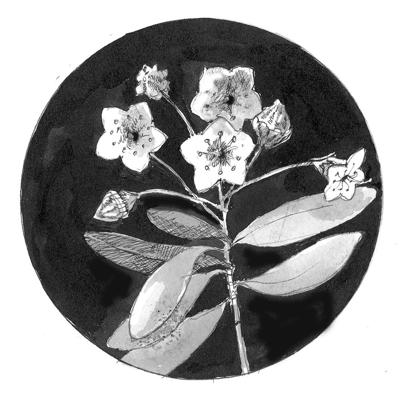If you were fortunate enough to grow up with freedom to roam outdoors, there are likely certain places that stick with you. For me, one of these places is a thicket of old mountain laurels that my brother and I hiked through on our way to an outcrop we called The Ledge. What I loved about them was how their shreddy, red-brown trunks forked and twisted, like trees in a fairy tale, or in the Haunted Forest on the way to Oz. In early summer, they held delicate pink and white flowers that were sticky to the touch — another sign that they were, if not enchanted, at least special.
Mountain laurel (Kalmia latifolia) is common in northwestern Connecticut, where I grew up, which is one reason it was selected, in 1907, as the state flower. (Pennsylvania followed suit in 1933.) Along with rhododendron, blueberry and huckleberry, this broad-leafed evergreen shrub is a member of the Ericaceae, the heath family. It is common in the eastern United States, and even southern Quebec, although uncommon or rare in the northern part of its range. It is a well-loved species, due to its exquisite flowers and the elongated leaves that give winter color to the woods as well as cover for wildlife.
The mountain laurels I remember sprawled and forked because they grew in a shaded spot. Their flowers were sparse for the same reason. But, although they are shade-tolerant, laurels like sun. Spectacular stands grow along roadsides and power lines. Their snowball-sized terminal flower clusters typically appear in late May and early June; in the northern edge of their range, they may bloom as late as July.
At first they’re two-tone, with the sealed buds darker than open flowers. Each cluster contains a crowd of five-sided cups ranging from white to pink, with contrasting dots and streaks of darker pink and purple.
It turns out my brother and I were right—the mountain laurel’s sticky flowers are special. The plant has a fancy system of dispersing pollen. Before opening, the anthers — the pollen-carrying parts of the flower — are protected from rain and wind inside ten little knobs. When the flower opens, the anthers are exposed. When a bumblebee enters looking for nectar, an anther springs up and slaps it on its hairy little back, dusting it with pollen. It’s efficient: most of the plant’s pollen ends up on a pollinator.
Some mountain laurel lovers transplant wild specimens, but they can be difficult to establish. Nursery stock is a more reliable option. About 80 named cultivars exist, according to Dr. Richard A. Jaynes, a horticulturist and plant breeder widely considered the mountain laurel maestro. He developed at least 25 during his career at the Connecticut Agricultural Experiment Station and at his Broken Arrow Nursery. The flowers of cultivars offer varied coloration, including bicolor.
I’ve always heard that mountain laurel is poisonous, but it is frequently browsed by deer. Kalmia leaves contain andromedotoxin, which is poisonous to livestock, particularly sheep (leading to one of its common names, lambkill). According to Jaynes, the plant is also toxic to deer.
“But they use it as a condiment. Somehow they know not to eat enough at one time to be poisoned by it,” Jaynes said.
He explained that deer typically eat laurel when they’re short of other food.
“In my experience, they like the cultivars best.”
Wood carvers also appreciate the plant. It is the favored wood of Dan Dustin, a New Hampshire spoon carver. He often goes out with a pack basket in search of a “spoony” laurel—an old one with branches as thick as his arm. Mountain laurel also has the name spoonwood, and legend has it that Native Americans carved it for this purpose.
“It’s lovely carving wood,” Dustin says. “It’s very stable, meaning it doesn’t like to crack as much as some other woods. That makes for easier carving, because it can be carved green. It’s white in color, strong and light and without any taste or perfume.” He estimates that he’s carved 20,000 spoons out of mountain laurel, and plenty from the wood of its relative, blueberry.
Mountain laurel is lovely wherever you find it, but some of the larger stands are worth a planned visit. Timing of the bloom is affected by elevation and latitude, as well as spring temperatures: an unusually warm, sunny spring moves the flowering season earlier by one to two weeks. There are very large specimens at The Fells, also known as the Hay estate, on the banks of Lake Sunapee. New Hampshire’s Russell-Abbott State Forest, Pisgah State Park, and Wontastaket State Forest have thick stands, as does Vermont’s Black Mountain Natural Area. Maine’s largest stand is in the Bijhouwer Forest in Phippsburg. Spectacular collections are found at Arnold Arboretum in Jamaica Plain, Massachusetts.
Laurie D. Morrissey is a writer in Hopkinton, New Hampshire. The illustration for this column was drawn by Adelaide Tyrol.
The Outside Story is assigned and edited by Northern Woodlands magazine, and sponsored by the Wellborn Ecology Fund of New Hampshire Charitable Foundation.















(0) comments
Welcome to the discussion.
Log In
Keep it clean. Please avoid obscene, vulgar, lewd, racist or sexual language.
PLEASE TURN OFF YOUR CAPS LOCK.
Don't threaten. Threats of harming another person will not be tolerated.
Be truthful. Don't knowingly lie about anyone or anything.
Be nice. No racism, sexism or any sort of -ism that is degrading to another person.
Be proactive. Use the "Report" link on each comment to let us know of abusive posts.
Share with us. We'd love to hear eyewitness accounts, the history behind an article.